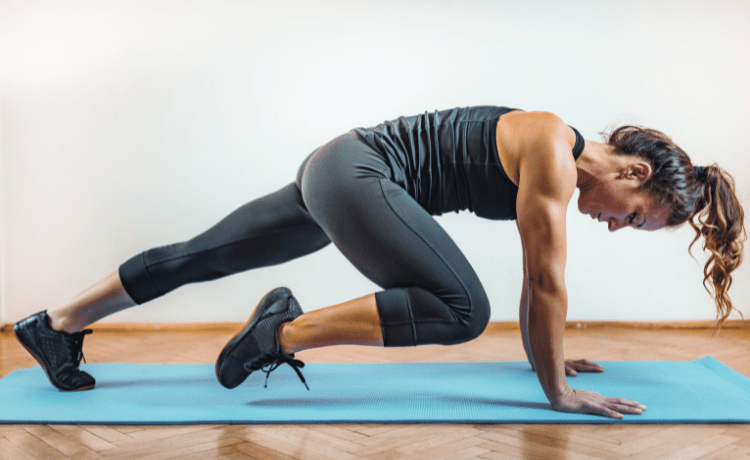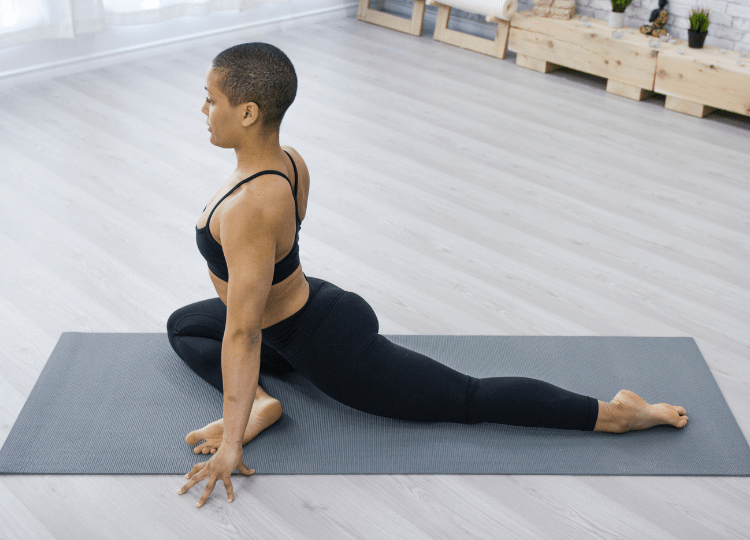If you’re looking to target your outer quads and discover which exercises will help you isolate this part of your legs, you’re in the right place…
This article delves into everything you need to know about training the elusive “outer quad” and includes a list of the 8 best exercises to get started.
You may think creating a list of the best exercises for the outer quad is relatively straight forward, but that couldn’t be further from the truth. You see, this relates to one of the most heated debates amongst personal trainers and gym goers around the world… “is it possible to train the outer and inner quads separately?“
The answer? It really depends on who you ask.
Although many strength athletes will swear by using a narrow stance and having your feet pointing inwards during leg exercises to focus more on the outer quads, there is currently little scientific research that backs it up. As a result, it’s hard to categorically provide exercises that exclusively target the outer quad more than the inner quad.

Whether you have big or small outer quads (compared to your inner quads) is more likely to do with genetics.
Nevertheless, there are still some key things to consider if you want to either bulk up or add definition to this part of your body… as this article explains.
Although a narrow stance doesn’t necessarily mean you are isolating the outer quad, it does mean the quads in general are getting more engaged than the glutes… and this is definitely worth noting, because it means we can be confident in doing exercises that focus more on the quads compared to the glutes and hamstrings (for example, a front squat will put more emphasis on the quads compared to a traditional back quat).
And when it comes to building up your “outer quads” (or your vastus lateralis muscle if you want to sound knowledgeable)… it’s likely that you actually just need to keep developing the quads as a whole if you want to gain strength, mass or definition in either the inner or outer part.
So, whether you’re looking to add muscle mass to achieve the “quad sweep” or simply tone up and add definition to your outer quads, try following the exercises and tips below to get started.

A FITTER, STRONGER YOU
A simple science-based workout plan that is proven to help build muscle, burn calories and lose weight. Suitable for all levels.
Our Top Outer Quad and Thigh Exercises
Leg Press
The leg press is one of the most popular gym exercises to target the legs. A leg press will engage the quads, hamstrings, glutes and calves… but your foot placement can influence which muscle group (namely the quads or the glutes) take more of the load.
A narrower stance on the leg press will put more emphasis on your quads.
When testing out new foot placement, it’s always worth keeping things light. Make sure you feel comfortable with the movement before adding more weight to the leg press machine.
Seated Leg Extension
Seated Leg Extensions are an isolation exercise, focusing on the quads. Unlike squats, deadlifts and leg presses, which are compound movement, leg extensions mainly involve engaging the quads to lift the weight.
If you want to target your outer quads, then including exercises like leg extensions are a great place to start. This is because your glutes or hamstrings can’t compensate or support weak quads (like they can in other compound movements).
By doing such isolation exercises, you may discover your quads are weaker than your hamstrings and glutes… which not only would cause muscular imbalances that lead to injuries, but also the appearance of smaller quads (both inner and outer parts).
Front Squat
The front squat is a great variation to the traditional back squat. It involves holding a barbell in front of your chest (which you’ll realize is directly above the quads).
This subtle change has a big impact on the distribution of weight. With the bar above your quads, it forces this muscle to push down harder to lift you up out of the squatting position.
For added difficulty, adopt quite a narrow squat too, which will really focus on the quads compared to the traditional squat.
Similar to some of the other exercises, if you suddenly discover that you struggle with front squats compared to back squats, it likely points to muscular imbalances, whereby your glutes, hamstrings or general technique has masked potential weakness in your quads.
Narrow Squat
If you want a break from using weights, the simple bodyweight squat with a narrow stance is certainly not to be ignored.
This can be incorporated into all sorts of workout styles… including higher repetition routines that focus more on building muscular endurance and definition (as well as cardiovascular benefits).
Eccentric Squats
Sticking with squats, another option is to slow down the lowering phase of the movement… known as eccentric training.
With squats, you’ll notice it’s the quads that are engaged and activated during the lowering part, so slowing down this phase of the squat will keep the quads under tension for longer.
Narrow Wall Sits
Wall sits is an isometric exercise… which means the muscles are engaged and contracted while in a static position (i.e. they are not moving). This differs from every other leg exercise in this list, whereby you are either moving at the hips or knees, to create resistance.
The wall sit is, nevertheless, still very effective, even without your muscles actually moving.
The weight of your body will force the quads (and glutes, hamstrings and calves) to activate in order to keep you from falling to the ground.
Wall sits are a very functional movement, that help translate into everyday uses… but they also help build endurance in the quads, which can benefit other strength training activities.
You can also add resistance to wall sits by having a training partner add weighted plates to your lap.
Bulgarian Split Squat
The Bulgarian split squat involves placing one foot behind you on an elevated surface, such as a bench or chair. This means that you are using one single leg to power yourself up from the squat.
This position places more emphasis on the quads, as well as requiring a good level of balance and stability to do it properly.
You can also add weight (barbell, kettlebell or dumbbells) to increase the difficulty.
You may need to experiment with the foot placement, as it will depend on your physique. Once you’ve found that sweet spot, it’s a good idea to place some tape on the floor so you can quickly get into the best position when you’re changing legs.
Decline Slant Board Squats
Elevating the heels whilst squatting is another effective way to put more emphasis on the quads.
By elevating the heel, you are increasing the range of motion at the knee and reducing it at the hips. This ultimately means the quads are activated for longer.
There are various way to elevate your heels… one of the easiest and most effective being the use of a slant board.
Slant board squats are also useful for those who struggle with ankle mobility, as you’re reducing the range of motion at the ankles too.
Tips for Targeting the Outer Quads and Thigh
Improving Ankle Mobility
Ankle mobility is often a factor holding people back from progress with various leg exercises. This mobility and flexibility in the ankles will impact the positioning of your body and can result in poor form if mobility is limited.
When you want to target the quads, you need your ankles to be mobile and flexible, ensuring you can keep an upright position to engage the quads more.
Asian squats are a great test of your ankle mobility. If you can’t adopt this stance comfortably, then it’s worth including ankle stretching into your weekly routine.

Training for Mass or Definition?
There could be any number of reasons why you want to target and train your quads/outer quads… from gaining muscle mass, to adding definition, to improving athletic performance.
Your goals should largely influence how you approach workouts, including quad exercises.
As a general rule, if you want to add muscle mass and size, focus on heavy weights and lower repetitions. If you want to lose weight or tone up, focus on lighter weights and higher repetitions.
Body Fat
Lots of people searching for the elusive “quad sweep” are those focusing on the aesthetics of the muscle, such as bodybuilding. A key component to this is body fat. As well as including the relevant exercises in your workout, your body fat percentage is going to influence the overall appearance of the quads.
Point Feet Inwards?
Although there is a lack of scientific evidence relating to the effectiveness of pointing your feet slightly inwards during exercises like squats to better target your outer quads, this methodology still has a large and loyal following.
Is it worth trying? That’s for you to decide.
If you do, it could pose a higher risk of injury, especially around the knee, so bear that in mind.
You are probably better off focusing on following the exercises listed above and developing your quads as a whole, instead of trying to “isolate” the outer part.
Tight Hips
Along with stiff ankles, tight hips will also be a contributing factor to how well you can target the quads. If you have limited range of motion of your hips, your positioning during certain exercises may naturally put more emphasis on the glutes or hamstrings, for example.
If left unaddressed, this can mean with every workout, your glutes and hamstrings are continuingly taking the brunt of the weight, with your quads failing to ever be fully activated.

Genetics
Something we mentioned in the introduction that is worth highlighting for those following more of a bodybuilding routine, is that genetics may impact the shape of your quads… i.e. you may naturally have larger inner or outer muscles of the quad.
Benefits of Quad Strengthening Exercises
Lower Body Strength and Power
One of the main benefits of focusing on your quads is to help support better lower body strength and power.
From daily activities like standing up out of a chair, to playing all sorts of sports… having strong quads helps to improve movement and performance.
Like any group of muscles, to get the most out of your quads, you want to ensure your hamstrings and glutes are similarly matched… i.e. they aren’t notably weaker or stronger.
Protect the knee
Weak quads are more likely to put unnecessary pressure on the knees, resulting in pain and injury.
Stronger quads help to protect the knee and ensure the quad muscle takes the pressure and force of movements.
Bottom Line
Although it may not be possible to isolate the outer quad… by following along to the recommended outer quad exercises listed above, it is certainly possible to adapt common movements to help build stronger, more defined quads.
Related Articles
